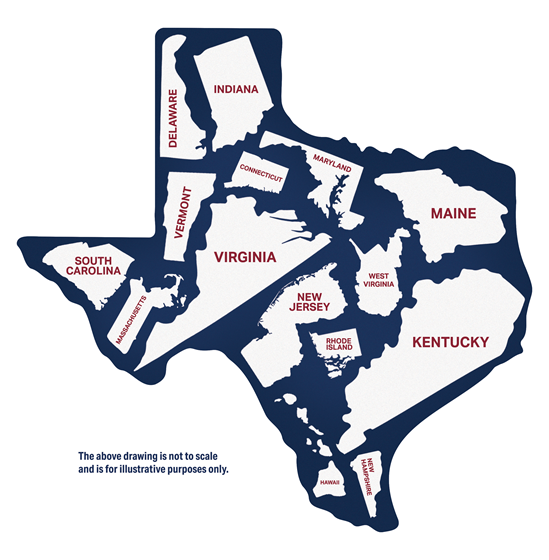Public Schools, Not Vouchers, Offer the Most School Choice
Despite the escalating political rhetoric about taxpayer-funded private school vouchers, the truth remains: Texas public schools are the leaders in providing families with the most academic, athletic, career and technical, and extracurricular choices.
Claims that vouchers will give Texas families more choices run counter to what is actually happening in public schools across the Lone Star State, where opportunities abound for students to select schools and programs that best fit their needs and interests.
Among the state’s 1,026 public school districts, families already have the choice to select magnet campuses, public charter schools, public online schools, or a more traditional K-12 option.
Within many school district boundaries, families also have the option of open enrollment — or the ability to select a school other than the one in their attendance zone. Neighboring school districts sometimes allow transfers among students to accommodate specific needs, including academic, health, and family issues.
That’s the big picture for public school choice in Texas. Here are some other key truths to consider when comparing the choices offered by Texas public schools with those promised by voucher proponents.
Vouchers Give Private Schools — Not Parents — the Right to Choose
When voucher proponents talk about choice, they are essentially advocating for private schools to choose which students to admit — and at what cost to the families. There’s little doubt that taxpayer-funded vouchers will pick up only a fraction of private school tuition, leaving Texas parents to dig deep into their pockets for the rest.
Those who advocate for vouchers are not advocating for parents’ rights. Texas families will have fewer opportunities to find out what’s happening inside their child’s school because private schools are not required to comply with state accountability and assessment standards, open records laws, special education rules, or curriculum requirements.
And among the conversations happening about education today, it’s important to remember that public schools give parents a way to be part of the discussions and the decision-making through locally elected school boards that are accountable to voters. Vouchers transfer the power of engaged parents to privately owned organizations and corporations, accountable only to their bottom line or inaccessible board of directors.
In Rural Communities, Vouchers Aren’t a Real Choice
Those who champion vouchers are out of touch with the realities of a state that encompasses nearly 270,000 square miles — second in size in the U.S. to only Alaska and big enough to simultaneously fit 15 of the smallest states, including Kentucky, Virginia, Indiana, Maine, South Carolina, West Virginia, Maryland, Vermont, New Hampshire, Massachusetts, New Jersey, Hawaii, Connecticut, Delaware, and Rhode Island.

Of the 5.4 million public schoolchildren in Texas, nearly 950,000 live in rural areas, where options other than their local public schools are few and far between. It’s disingenuous to claim that vouchers will give these families more choice when that means driving dozens of miles every day to a private or religious school. It’s not a realistic option for hard-working Texas families in rural areas of our state.
That’s precisely why Texas’ rural lawmakers have long opposed voucher programs. They know that vouchers would weaken their local public schools, which for generations have rightfully been the pride of their communities.
Vouchers Aren’t the Better Educational Choice
A central argument for establishing a publicly funded voucher program is that students in failing schools would have access to a better education. The research clearly suggests otherwise.
An often-cited 2016 report tracked the progress of students receiving private school vouchers in Louisiana and found “strong and consistent evidence that students using an LSP [Louisiana Scholarship Program] scholarship performed significantly worse in math after using their scholarship to attend private schools” (p. 8).
In 2017, a group of researchers did an extensive survey of available studies and concluded “the evidence to date is not sufficient to warrant recommending that vouchers be adopted on a widespread basis.” They noted that awarding students a voucher is not a reliable way “to improve educational outcomes.”
Rather than funnel public money into a new voucher system with no guarantees, those seeking to expand school choice in Texas should consider how to do that within the current public school system, which already has experience in implementing new programs and initiatives to expand options for students.
Texas Public Schools Are Leaders in Choice
The data is clear on how well public schools in Texas are doing in terms of expanding educational options and choices for their students through specialized and personalized learning opportunities.
Here are some important highlights of that success, documented by the Texas Education Agency:
- Texas has nearly 200 public Early College high schools designated across the state, giving students a way to graduate with both a high school diploma and an associate degree.
- More than 1 in 5 Texas public school students in grades 11 and 12 took at least one AP or IB exam in 2019-20, helping ensure college readiness.
- More Texas public students are taking Career and Technical Education classes than ever before, with nearly 60% enrollment in 2019-20, up from about 21% in 2009.
- Nearly 40,000 Texas public high school students graduated with an approved industry-based certification in 2018-19, meaning they were qualified for everything from construction to health sciences.
- Across the state, 1,118 campuses offer dual-language immersion programs that give students the opportunity to be bilingual and bicultural.
- School districts across the state are offering innovative courses in more than 150 disciplines, including maritime sciences, sports medicine, pipefitting, engineering design, and aviation, giving students the opportunity to learn real-world skills while earning their diploma.
Summary
School choice is well established within Texas public school districts and growing yearly as locally elected school boards respond to the unique needs of their students and families. Arguments for vouchers miss the essential fact that public schools have always been the leaders in school choice and a source of innovation in designing new programs that respond to what their communities need, what their families want, and what children deserve.
In fact, the opportunities available within public schools today are very much the result of engaged parents, who have been advocating for innovative options and programs with their elected school trustees — whether in school board meetings, the grocery store, or via email. Diverting public tax dollars into a voucher scheme that doesn’t follow the rules of open government will certainly diminish the voices of parents in favor of subsidizing corporations and private entities.
Let’s keep public tax dollars where they can benefit the public good. Texas families don’t need vouchers to get the best education for their students — they already have that choice among the 1,026 public school districts in the state.
Download School Choice PDF




